
Historical
and Cultural Context
Historical and Cultural
Context | Site
Map | On-Line
Resources | Rules
of Thumb | Glossary |
Quotes | WordList
| Co-Teachers - Doug
and Melissa | Gallery
E-Mail Doug at mrdoug@aznet.net
or Melissa atmelissa.granadatreehousestudio@gmail.com
Events that
shaped the arts from 1860's to
1914. |
Art Nouveau -
Artists
Art Nouveau (1880's-1914)
Art Nouveau is an elegant decorative art style characterized by
intricately detailed patterns of curving lines. Somewhat rooted in
the British Arts and Crafts Movement of William Morris, Art Nouveau
became popular across Europe and in the United States.
Leading practitioners included Aubrey Beardsley, Gustav Klimt,
Alphonse Mucha, and the American glassmaker Louis Comfort
Tiffany.
Art Nouveau remained popular until about the time of World War I,
and was ultimately replaced by the Art Deco style. Artcyclopedia
- http://www.artcyclopedia.com/history/art-nouveau.html
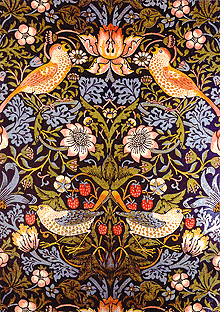
Designed by William Morris (1834-1896) for Morris
& Company - Strawberry Thief Chintz - 1883 -
http://www.lbwf.gov.uk/wmg/selectc.htm
Events
that shaped the arts from 1850's to 1914.
See Impressionist
and Post-Impressionist
for additional events. | Top
1851 - The Great Exhibition opened in London's Hyde Park in
the Crystal
Palace, a million square feet of glass on a framework of bare
iron forming its walls and roof. The Great Exhibition celebrated the
height of civilization to which the whole of mankind had risen (WH,
pp. 546-547).
1854 - After 250 years of almost no contact with the
industrialized countries of the world, American Commodore Matthew
Perry coerced Japan into opening it's doors to Western trade and
diplomacy (WH, p. 584).
1859 - Englishman, Henry Bessemer developed a less costly
way to make steel. He forced blasts of hot air through the molten
iron to burn out impurities. Bessemer began using his new "blast
furnace" in 1859 in his factories at Sheffield (WH, p. 594).
1865 - Lewis Carroll's first edtion of Alice's Adventures
in Wonderland appeared. Both Tenniel, the illustrator, and Carroll
condemned the book because the pictures were printed poorly. Some of
these 2000 copies were given by Carroll to hospitals and institutions
where he thought the book might be enjoyed and some were sold in
America. It was six years later that Through the Looking Glass was
published (http://www.victorianstation.com/authorcarroll.htm).
1874 - First impressionist
exhibition held in Paris.
1879 - Thomas Alva Edison developed the first practical
electric light bulb (WH, p. 595).
1884 - Brussels - Term "art nouveau" appears in print for
the first time, describing the Belgian artists' group "Les XX"
(http://www.nga.gov/feature/nouveau/exhibit_time.htm).
Top
1889 - The invention of the electric elevator made possible
a new kind of building for crowded cities -- the skyscraper.
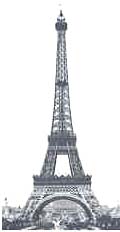
Alexandre Gustave Eiffel - http://www.discoverfrance.net/France/Paris/Monuments-Paris/Eiffel.shtml
The Eiffel Tower is built for the Paris World's Fair. However, the
controversial tower elicited some strong reactions, and a petition of
300 names -- including those of Maupassant, Emile Zola, Charles
Garnier (architect of the Opéra Garnier), and Dumas the
Younger -- was presented to the city government, protesting its
construction. The petition read, "We,
the writers, painters, sculptors, architects and lovers of the beauty
of Paris, do protest with all our vigour and all our indignation, in
the name of French taste and endangered French art and history,
against the useless and monstrous Eiffel Tower."
1893 - Great Britain - Aubrey Beardsley design published in
the first issue of the magazine The Studio.
Paris - Japanese prints exhibition organized by Siegfried
Bing.
Henri de Toulouse-Lautrec paints Jane Avril at the Jardin de
Paris.
Brussels - Victor Horta designs the Tassel House.
Chicago - Columbian World's Fair; Adler and Sullivan design the
Transportation Building.
Women win the right to vote in New Zealand, the first country to
embrace female suffrage. In Belgium universal male suffrage is
adopted (http://www.nga.gov/feature/nouveau/exhibit_time.htm).
1900 - When the authorities planned to open the brand new
Parisian metro in 1900, a design competition was organized for the
entryways kiosks. A certain Hector Guimard, young architect of 32
years old, who had adapted Art Nouveau, (he discovered and learned in
Brussels from Victor Horta) won the contest. Guimard's idea was to
brighten up a little bit the daily monotony of the crowds going to
work, jammed in public transports.
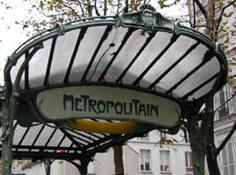
Hector Germain Guimard - Paris Metropolitain
entryway kiosk - 1900 -
http://www.jack-travel.com/Paris/ParisHtml/Hector_Guimard_Metro_Entrance.htm
1901 - William Knox D'Arcy, a British speculator, made a
deal with the shah of Persia, paying him a share of the profits in
exchange for the right to drill oil wells in Persia (WH, p. 669).
Top
1908 - D'Arcy made the first oil strike in the Middle East.
Soon his company, the Anglo-Iranian Oil Company, controlled the
industry in Iran (WH, p. 669).
1910 - A revolution begins in Mexico, overthrowing
President Porfirio Diaz the following year. The United States sends
military forces, changing the nature of U.S.-Mexican relations.
The trans-Andean railroad between Argentina and Chile opens.
The Portugese monarchy ends after a revolution in Lisbon.
Edward VII of Great Britain dies and is succeeded by his son, who
is crowned George V.
China abolishes slavery (http://www.historychannel.com/).
1911 - A revolution in China ends the 267-year Qing dynasty
and introduces liberal reforms. Nationalist leaderSun Yat-Sen returns
from exile and is elected president of the new republic.
American banana shipper Samuel Zemurray sponsors a coup in
Honduras to establish a government more favorable to banana
growers.
Revolutionary leader Francisco Madero becomes the new president of
Mexico, succeeding ousted dictator Porfirio Diaz.
The Supreme Court orders the breakup of John D. Rockefeller's
Standard Oil Company, citing the monopoly has engaged in unreasonable
restraint of trade in the oil industry.
German novelist Thomas Mann publishes his classic novella Death in
Venice.
Irving Berlin's song Alexander's Ragtime Band popularizes ragtime
for mass audiences (http://www.historychannel.com/).
Top
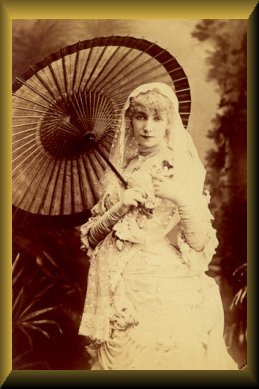
Sarah Bernhardt - "The Divine Sarah", is the woman
who is perhaps most responsible for popularizing the classic
mousquetaire style of glove in America and Europe during the late
1870's and early 1880's. http://www.geocities.com/michelelynn5/sarah.html
Sarah Bernhardt made her first successful film, a hand-colored
two-reeler of La Dame aux Camellias, better known to American
audiences as Camille. She flat-out did this for the money, an
impressive $30,000. Co-starring her new young discovery Lou Tellegen,
the film attracted a higher class of audiences to the moving picture
houses. One critic wrote that "Bernhardt is the perfect mistress of
gesture, pose and expression, and the pictures make the story
thrillingly plain." (http://www.classicimages.com/1997/june/bernhard.html)
1912 - New Mexico and Arizona are admitted as states, the
last new states to be admitted to the union until 1959.

RMS Titanic - 1912 - http://titanic.gov.ns.ca/museum.html
also see http://www.titanic.com/
The Titanic sinks on its maiden voyage after hitting an iceberg in
the North Atlantic. 1,513 passengers are lost, 711 are rescued.
Pravda first appears as the official publication of the
Russian Communist party.
In the movie industry, Universal Pictures is founded by several
film producers including German Carl Laemmle, who later heads the
company (http://www.historychannel.com/).
Top
1913 - Mexican President Francisco Madero is killed in a
coup. Victoriano Huerta proclaims himself president, while rebel
leader Francisco Pancho Villa leads an uprising in Northern
Mexico.
The Armory Show in New York introduces cubism to the United
States. Among the artists shown are Marcel Duchamp, whose Nude
Descending a Staircase shocks visitors.
The Sixteenth Amendment permits Congress to levy a graduated
income tax, the beginning of the era of regular personal
taxation.
The ballet Rites of Spring premieres in Paris with
choreography by Vaslav Nijinsky. The audience riots over Igor
Stravinsky's dissonant score.
Coco Chanel opens a boutique in Deauville, France. Her styles and
use of knits revolutionize women's fashion.
Built by Cass Gilbert, the Woolworth Building opens in lower
Manhattan. At 60 stories, it will remain the world's tallest building
until 1931 (http://www.historychannel.com/).
1914 - World War I breaks out in Europe after the
assassination of Archduke Ferdinand of Austria, catapulting most of
Europe into a cataclysmic conflict within months.
U.S. forces invade the port city of Vera Cruz in Mexico in
response to ongoing anti-American acts in the revolution-torn
country.
Mohandas Gandhi returns to India after 21 years in South Africa
and begins a non-violent campaign against British rule.
After ten years of work and 30,000 casualties suffered in its
construction, the Panama Canal opens to shipping traffic.
Irish author James Joyce publishes his collection of short
stories, Dubliners, followed shortly by his novel, Portrait
of the Artist as a Young Man.
Feminist Margaret Sanger coins the term birth control in her
newspaper, Woman Rebel (http://www.historychannel.com/).
Art Nouveau - Artists
| Top
- Edmond-François Aman-Jean - 1860-1935 - French
Painter
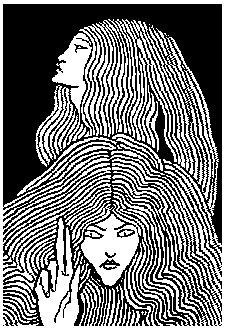
Aubrey Beardsley - Design for chapter heading from Le
Morte Darthur, 1893-4 - http://www.glyphs.com/art/beardsley/
- Aubrey Beardsley - 1872-1898 - British Illustrator
- Félix Bracquemond - 1833-1914 - French
- Lucien Lévy-Dhurmer - 1865-1953 - French Painter
- Georges de Feure - 1868-1928 - Dutch Painter
- Emile Gallé - 1846-1904 - French Glassmaker
- Antoni Gaudí - 1852-1926 - Spanish Architect
- Hector Guimard - 1867-1942 - French Architect/Designer
- Ferdinand Hodler - 1853-1918 - Swiss Painter
Top
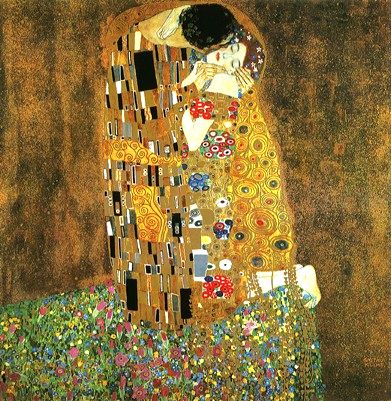
Gustav Klimt - The Kiss - 1907-8 -
http://www.artcyclopedia.com/artists/detail/Detail_klimt_gustav.html
- Gustav Klimt - 1862-1918 - Austrian Painter
- Georges Lemmen - 1865-1916 - Belgian Painter
- Charles Rennie Mackintosh - 1868-1928 - Scottish Designer
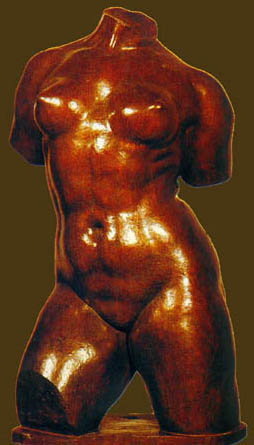
Aristide Maillol - Torso of the Monument to
Blanqui - 1905 -
http://www.ocaiw.com/nmaillol.htm
Top
- Aristide Maillol - 1861-1944 - French Sculptor
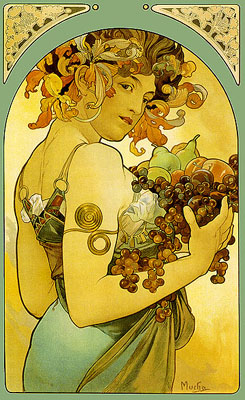
Alphonse Mucha - Fruit -1897 -
http://www.primenet.com/~byoder/artofam.htm
- Alphonse Mucha - 1860-1939- Czech Illustrator - Alphonse Mucha
was a very influential but seldom mentioned figure in the history
of art. He is more than anyone else responsible for the "art
nouveau" style that developed around the turn of the century and
applied his considerable talents to a wide variety of pursuits
ranging from painting and sculpture to poster, magazine, and
calendar illustration, and product and architectural design.
- Johan Thorn Prikker - 1868-1932 - Dutch Illustrator
- Giovanni Segantini - 1858-1899 - Italian Painter

Louis Comfort Tiffany - View of Oyser Bay ,
ca. 1908 -
http://www.metmuseum.org/explore/Tiffany/8.htm
- Louis Comfort Tiffany - 1848-1933 - American Stained Glass
Artist
Historical and Cultural
Context | Site
Map | On-Line
Resources | Rules
of Thumb | Glossary
| Quotes
| WordList
| Co-Teachers - Doug
and Melissa
| Gallery
| Top
E-Mail Doug at mrdoug@aznet.net
or Melissa at melissa.granadatreehousestudio@gmail.com
|

|
Melissa and I would like to
thank znet
for
making a commitment to
education and WriteDesign.
|











